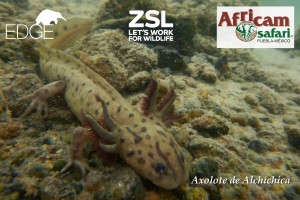EDGE Fellow Jose Alfredo Hernández Díaz recounts the highlights from his first three visits to monitor Taylor’s salamander in Lake Alchichica, Mexico…
Six months ago, we started an adventure in search of the Critically Endangered Taylor’s salamander. At the beginning we had the uncertainty of if we would find any salamanders but, at the same time, we felt the excitement of working with a very challenging and mysterious species, for which almost everything remained unknown. After the first visit to Alchichica, when we tested the methodology for trapping salamanders and conducted many observations of the salamander’s behaviour, we thought that we knew enough about the lake to work without trouble. However, the next two trips have taught us that the lake and the salamanders are not as predictable as we had thought.

The weather was the biggest challenge during the second trip to Alchichica. We knew from our previous experience that the wind could be strong in the afternoon, but it was normally weak during the morning. Nevertheless it was different in July. The first two days in the field were peaceful and very successful. The weather was perfect and we had caught 19 salamanders, an amazing number! But things changed for the next two days. The wind started blowing very early in the morning and we were not able to work properly. Big waves appeared in the lake and we couldn’t move the boat even when we rowed with all our strength. We caught only two salamanders that day and we were not able to check all the traps because the wind dragged us to the shore. For the last day, we decided to start working earlier. We started working at seven o’ clock in the morning, the wind was strong but we were able to check almost all our traps. Sadly the current dragged five traps and we couldn’t find them. We only caught two salamanders that day, for a total of 24 individuals. At the end, despite the weather, we were able to find many salamanders, which was very good news!

For the third trip, we were “prepared for everything”. We changed our schedule and started working from seven o’clock in the morning, in order to avoid the strong wind from noon. We added more weight to the traps and a plastic bottle as an extra float, so they could not be dragged by the current nor get lost, and we also changed the string for a stronger one so it could not break. Everything was “under control”. But as always, the unpredictability from the lake appeared. On the first day, the weather was perfect; we set all the traps in less than three hours, without fighting against the wind. And even better, we found three of the five traps that we had lost two months ago, in perfect condition and without any trapped salamanders. On the second day, the lake was fully covered by mist and it was impossible to see farther than two meters away! It was very difficult to see the traps from the distance; however we managed to find almost all of them.

Despite all our strategies, we still experienced some difficulties with our traps. We could not find one of them in the lake when we first checked, we saw it from the shore later, but the current had dragged it about 700 meters! The good news was that the plastic bottle saved it from sinking because the depth was 60 meters in the exact spot where we found it floating. The new string also experienced some trouble, because it didn’t float and got tangled in the stromatolites, so it was very difficult to get the traps out from the water. Indeed we needed help from a group of divers who rescued two traps that were stuck on the bottom of the lake at 20 m depth. The traps were not very lucky this time, we only caught 13 salamanders in them. However there is always good news. During the night surveys we caught 25 salamanders and found many more that we couldn’t catch. We also discovered very interesting things.

The most impressive to me is that salamanders are able to live close to people. They are very abundant in an area right in front of human settlements. The structure of the stromatolites in that area gives salamanders refuge and seems to protect them from the waves. Some medium-sized and small salamanders live there while many other larger individuals come during the night from deeper areas. According to this, it seems that human disturbance is not affecting them in that area of the lake.
At the end of the trip, with help from local authorities, we organised a rubbish clearance contest. We invited local families to participate, and there were prizes for the three winning families. The prizes were free tickets for the zoo. Many people participated, including policemen and local public servants from the municipality. All of them were very enthusiastic and the local mayor offered breakfast for all the participants at the end. We also gave all the participants a postcard with the image of a Taylor’s salamander as a gift and a reminder of the amazing creature that inhabits the lake.

Alchichica and Taylor’s salamander represent a very interesting challenge; we have had some difficulties but we have achieved many interesting and promising results. Local people are interested in the project and even better, they are willing to help us save the salamander and the lake. So we will keep working hard to save this salamander from the edge of existence.
